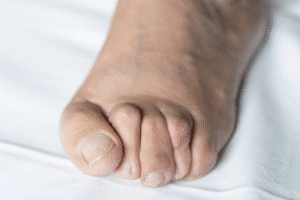
What Are Hammertoes?
Hammertoe is a common foot deformity where the toe bends abnormally at the middle joint, making it look like a hammer. This condition usually affects the second, third, or fourth toe and can cause discomfort, pain, and difficulty walking. Hammertoes often result from muscle imbalances that put too much pressure on the tendons and joints, leading to bending and stiffness over time.
Learn more about our approach to Foot and Ankle Care.
Causes of Hammertoes
Several factors can contribute to the development of hammertoes, including:
- Improper Footwear: Tight, narrow shoes or high heels push the toes into an unnatural position.
- Genetics: Some people inherit foot structures that make them more prone to hammertoes.
- Injury: Stubbing, jamming, or breaking a toe can lead to hammertoe formation.
- Underlying Conditions: Arthritis can weaken the muscles and increase the risk of developing hammertoes.
- Aging: The muscles and tendons in the foot may weaken with age, leading to deformities like hammertoes.
Symptoms of Hammertoes
The symptoms of hammertoes vary depending on the severity of the condition. Common signs include:
- Bent toe shape: The affected toe remains curled or flexed.
- Pain and discomfort: Pain occurs when walking or wearing shoes.
- Corns and calluses: Shoe friction can cause thickened skin on the top or tip of the toe.
- Swelling and redness: The toe may become irritated due to pressure and movement.
- Limited toe movement: Over time, the toe may become stiff and difficult to move.
Diagnosis of Hammertoes
A healthcare provider can diagnose hammertoes through a physical examination. They may also order X-rays and imaging to assess the severity of the deformity and check for underlying joint damage.
Non-Surgical Treatment Options
For mild to moderate cases, non-surgical treatments can help relieve symptoms and slow the progression of hammertoes:
- Proper Footwear: Wear shoes with a wide toe box and low heels to reduce pressure on the toes.
- Toe Exercises: Stretching and strengthening exercises can help maintain flexibility and muscle balance.
- Padding and Orthotics: Custom orthotics or gel pads can reduce discomfort and prevent further irritation.
- Toe Splints and Straps: These devices help keep the toes straighter.
- Pain Management: Applying ice packs and anti-inflammatory treatments can reduce swelling and pain.
Surgical Treatment Options
If hammertoes become severe and non-surgical treatments fail to provide relief, surgery may be necessary. Surgical options include:
- Tendon Transfer: Moving a tendon to a different location to help straighten the toe.
- Joint Fusion (Arthrodesis): Removing part of the joint and allowing bones to fuse for stability.
- Joint Resection (Arthroplasty): Removing a portion of the joint to improve flexibility.
- Toe Implant or Pin Fixation: Using an implant or pin to hold the toe in a corrected position.
Explore Surgical Services at OSMC.
Recovery and Prevention
After surgery, patients typically need to wear protective shoes for several weeks. Physical therapy and toe exercises can aid in recovery and help prevent recurrence. To reduce the risk of hammertoes:
- Choose well-fitting shoes with adequate toe space.
- Perform foot exercises regularly.
- Avoid prolonged use of high heels or tight shoes.
- Manage underlying medical conditions that affect foot health.
When to See a Doctor
Consult a healthcare professional if you experience persistent foot pain, difficulty walking, or worsening toe deformities. Early treatment can prevent complications and improve mobility.
To get help, schedule an appointment with a Foot & Ankle Specialist at OSMC.


